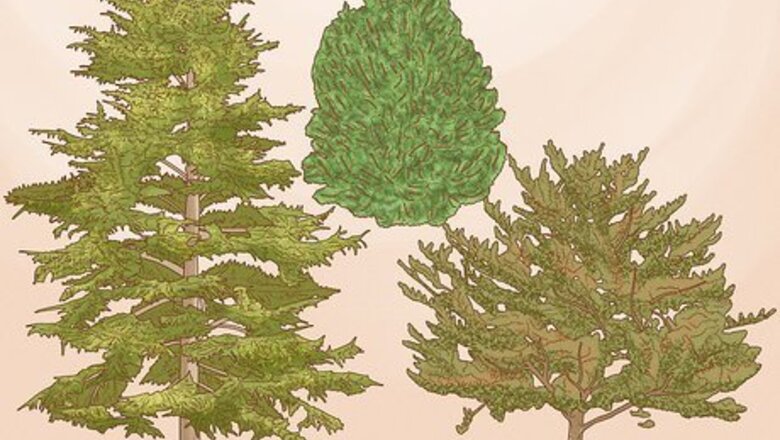
views
Planting a Pine Seedling
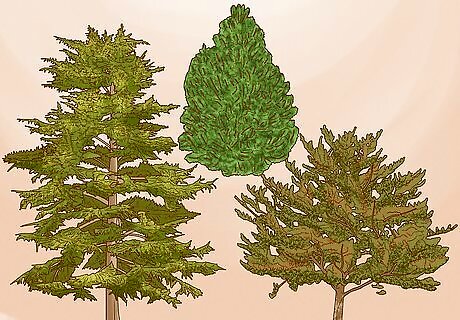
Choose the species of pine that is the best for your soil and your climate. Some types of pine trees used for landscaping include white pine, jack pine and Scotch pine. Ask the seller about growing environments if you live in a different climate or at a different elevation than the location where the seedling was grown.
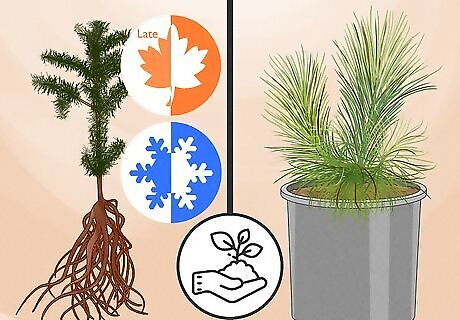
Decide between using bare-root seedlings or seedlings grown in a container. Bare-root pine seedlings must be planted during the late fall and winter, when pine trees are dormant. Container-grown seedlings can be planted at any time, although the hottest summer months will require additional shade and water to prevent dehydration and sun damage. Most seedlings can be kept for several weeks between 35º and 38º F (1.7 – 3.3ºC), but you should check with the seller in case the species you bought has different requirements.
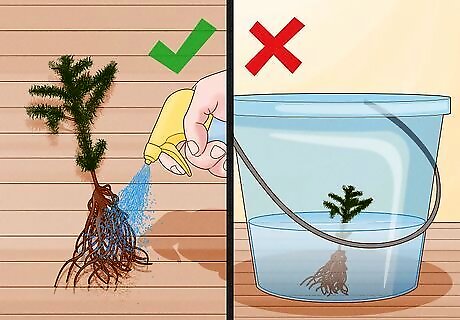
Lightly water the root system and rearrange it if necessary. Keep the roots damp until you are ready to plant, but refrain from soaking them in water, which could kill them. If the roots form a dense ball, or circle the sides the of the container, carefully rearrange the main root branches so they are more spread out. Some seedlings are sold with a small amount of soil mixture packed around the roots. Try to keep as much of this on the roots as possible while rearranging.
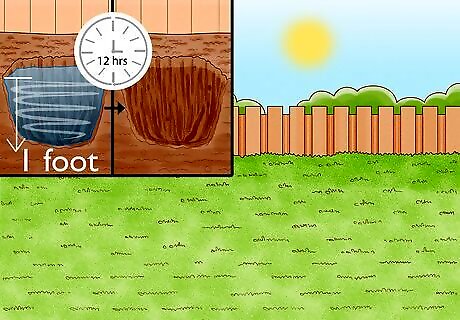
Choose the right area to plant your pine tree. Each pine tree should have plenty of open space, with no small plants around its base and no root systems of other trees nearby. Choose a location where the tree will receive direct sunlight during the cooler parts of the day. If you cannot plant a pine tree somewhere with shade on its west side, instructions are included below for creating a sun shade. A mix of sand and loam is best for pine trees, but you should only need to mix in suitable organic mulch such as sphagnum if the soil is a hard clay consistency. Choose an area with well-draining soil. A 1 foot (30 cm) deep hole filled with water should drain easily within 12 hours. If it does not, you may need to install drainage. EXPERT TIP “If you want to plant several pine trees together, it’s generally recommended that you plant them about 10–12 feet (3.0–3.7 m) apart.” Maggie Moran Maggie Moran Home & Garden Specialist Maggie Moran is a Professional Gardener in Pennsylvania. Maggie Moran Maggie MoranHome & Garden Specialist
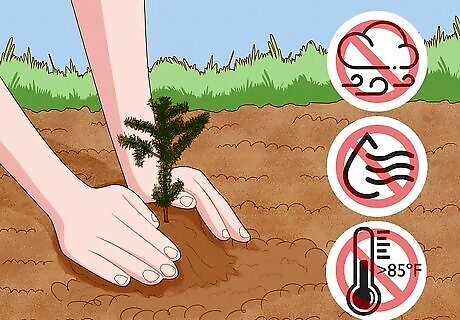
Choose a good day for planting. Do not plant trees when conditions are windy, dry, or above 85ºF (30ºC). The soil should not have standing water or ice on the day you plant, but should not be parched either.
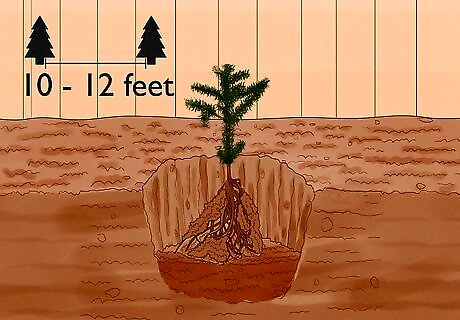
Dig a hole larger than the root system and fill the bottom with topsoil. The top layer of soil is the highest quality, so fill the bottom few inches (about 10 cm) with topsoil after you dig your hole. Be sure to dig the hole large enough that the roots still fit after you've added the topsoil. Warning: Contact your utility company to discover the location of underground lines before digging any large holes. Try to plant the tree to the same level it was planted in the nursery. If you're unsure, it is better to plant the tree too high than too low. If you’re planting more than one pine tree, be sure to leave at least 10 to 12 feet (3 to 4 m) of spacing so they can grow to mature width without any obstruction. Some varieties of pine may need even more space, like the huge Austrian pine.
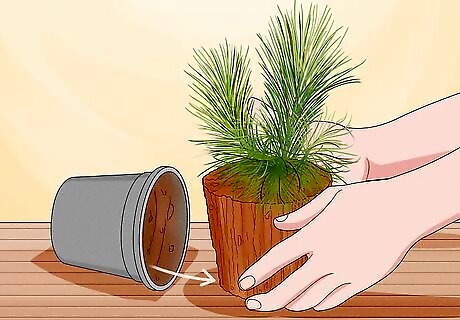
Remove the container or burlap from the seedling. Although burlap and other biodegradable material can be left on the plant, carefully removing it gives the seedling a better opportunity for growth.
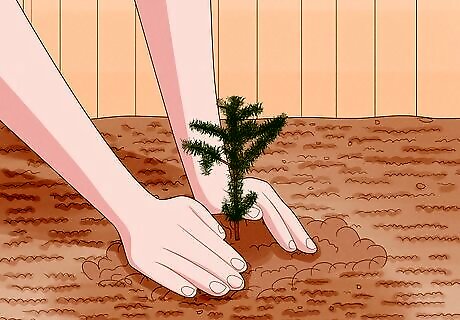
Place the pine tree roots carefully at the bottom and cover with soil. Fill the hole again after planting, periodically patting down loose soil with your shovel handle, not with your feet. Fill the hole until it is level with the surrounding soil, or slightly lower if the climate is especially dry, so water can run into the roots. Have an assistant hold the tree upright while you fill the hole if necessary.
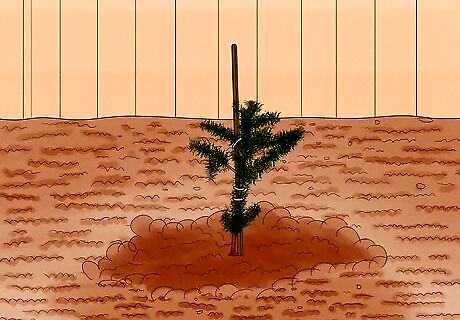
Lightly stake only if the tree cannot support itself. Staking pine tree seedlings is only necessary in areas of unusually high wind. If you think the pine tree is in danger of blowing over, use one or two stakes attached by ties or straps, and leave enough room for the tree to sway. Do not loop wire directly over the tree.
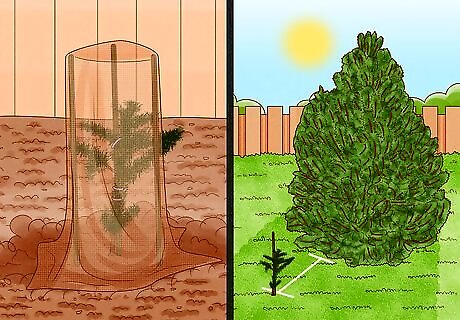
Protect young pines from hot sun. You may need to provide a sunscreen for your small pine tree by using a tarp or sheet of painted plywood. Planting where there is shade from another tree or a building is also a practical choice. The shade should be on the west side of the tree, which is where the sun is located during the hottest parts of the day.
Caring for a Pine Tree Seedling
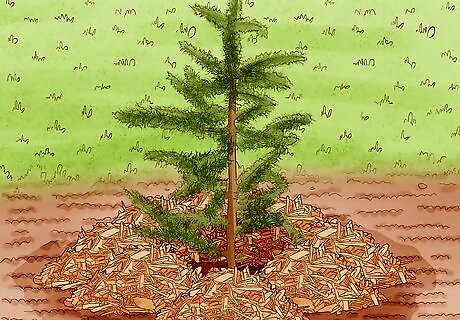
Mulch around the tree frequently. Wood chips are cheap and work well for pine trees. Apply them to several inches (centimeters) depth around the tree, leaving space around the trunk. While mulch should help control weeds in addition to providing good growing conditions, you should pull out any grasses or other small plants near the base of the tree if you do see any grow there. Do not use a plastic barrier underneath the mulch. The tree needs water and air to be able to pass through the mulch.
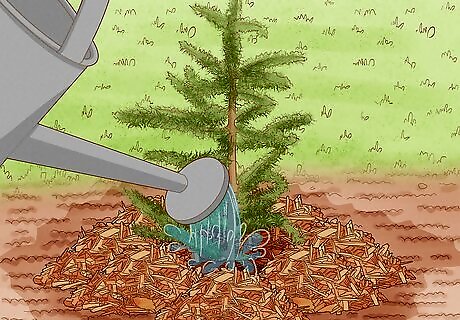
Water as needed depending upon type of pine, weather conditions, and soil. Instead of following one watering guide without variation, you should pay attention to how moist the soil is around your tree. Here are some tips: Soil that feels moist and holds together when picked up should not be watered, as over watering can suffocate the roots. Only water when the soil is mostly dry and crumbles apart, until it feels moist again. Water more in fall so the tree is prepared for winter. Water additionally during dry winter spells to protect young trees from drought, which is especially dangerous when the tree expects a wet season.
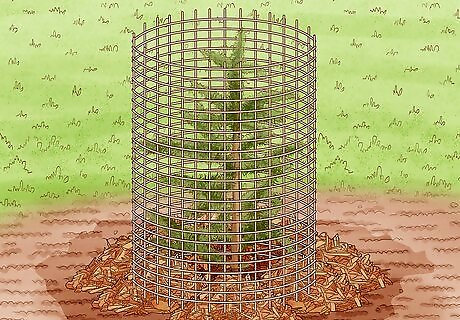
Protect the young pine trees from animals. A plywood sunscreen can also do double duty as an animal repellent. However, if you live in an area with deer or other persistent, large wildlife, you may need a plastic tube or chicken wire fence encircling the seedling.
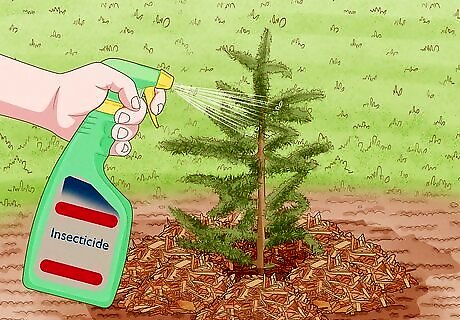
Protect young pine trees from pests. Pines can attract a number of insect pests, including weevils, boring insects like bark beetles, and sawyer beetles that spread the pine wood nematode. While these pests may or may not kill the tree, they can all do significant damage. Be proactive and try to protect your trees. Many pests can be controlled chemically by spraying seedlings with insecticide and fungicide. Trees may need repeated applications to kill off pests, as the larval stage of boring insects live underneath the bark and aren’t affected. You can also ward off pests by good management. Keep your trees healthy, for instance, as pests are less likely to attack healthy young saplings. Plant trees on medium soil to promote vigorous root growth and check your plantings often to prune dead or dying limbs. Planting some pine varieties (i.e. white) with hardwood trees or under a hardwood canopy seems to protect them from Dendroctonus bark beetles. It’s often best to remove damaged trees that will be vulnerable to pests. Always remove and destroy trees killed by boring insects, too.
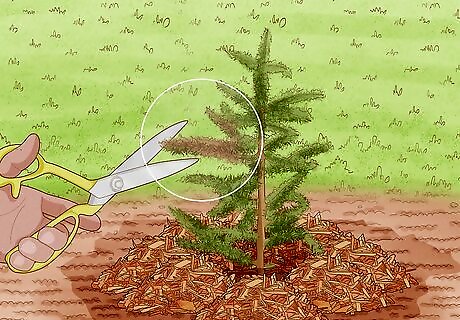
Prune dead or diseased branches only. Pruning to direct growth is not necessary for pine trees and may stunt their growth. Cut dead or diseased branches a short distance from the trunk, leaving the "branch collar" ring between the branch and the trunk. Follow the instructions in the article How to Prune a Tree carefully to avoid damaging your pine.
Growing Pine Trees from Seeds
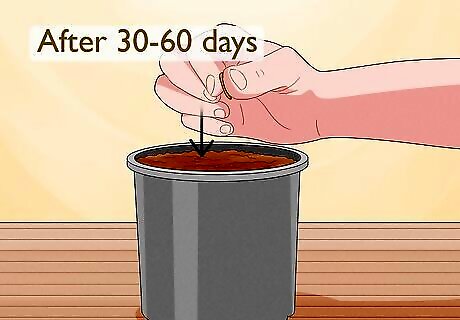
Understand how long this method takes. Growing pine trees from seeds can be a long, challenging process. You will have to acquire seeds when the pine cones are ripe, most likely in autumn. Depending on species and climate, you may need to prepare the seeds for 30–60 days as describe below before planting in pots. They will grow slowly, and may take over a year before they can be transplanted into outdoor soil without significant risk of death. While most pine cones ripen between August and October, some species such as the Scotch pine remain usable until March. Your local climate will also be a factor. Read the description of ripe pine cones so you know what to look for. See Growing Pine Trees from Seedlings for an easier, faster method.
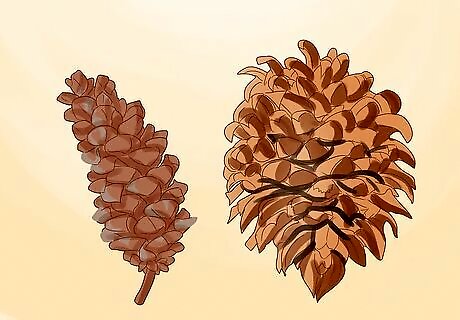
Collect large pine cones. Pine cones come in two varieties: small male cones and large female cones. Only the female cones produce seeds. Choose large pine cones with scales that are not fully open, or spread apart. If the scales are spread apart, they may have already released their seeds. You may take fallen cones or pick them from the tree by twisting them off the branch. Female pine cones are usually higher on the tree, so you may need a stepladder or a hooked pole. Choose brown or purplish pine cones, as fully green cones are not mature and have not produced useful seeds. Pine trees that have produced many cones are more likely to produce useful seeds.
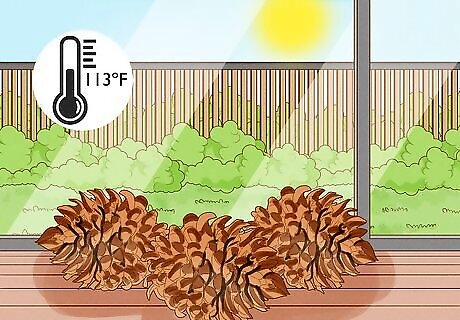
Spread the cones out on a dry, warm surface. Place them in direct sunlight if possible, and let them dry out so the scales open and give you access to the seeds. You may warm the room to speed this along, but do not heat the cones above 113ºF (45ºC).
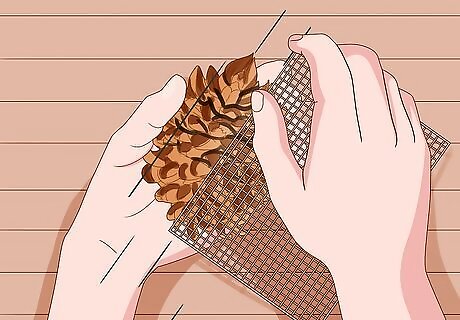
Extract the seeds. Each scale of the pine cone should have one or two seeds underneath it, sometimes attached to a thin "wing" for catching the wind. Shake the cones on a tray with 1/2 inch (1.25 cm) mesh or hardware cloth; the seeds should fall out of the cones and through the mesh. Shake over a tarpaulin to easily collect the seeds afterward. Use tweezers to pull out stubborn seeds, or if you only collected a few cones.
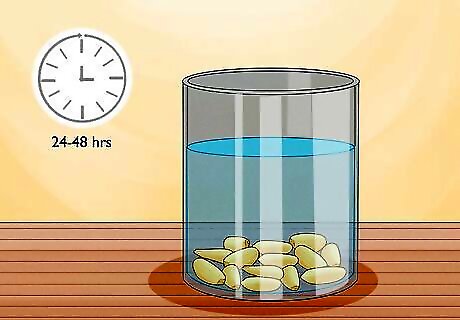
Put the seeds in a clear, water-filled container for 24–48 hours. Use room temperature water. Besides providing the seeds with water they need to begin growing, this provides a test of which seeds are usable. The full, viable seeds should slowly sink to the bottom of the container. The empty, unusable seeds will float to the top. Cut open one or two of the largest floating seeds to check whether they are actually empty. If they are full, wait longer for the remaining seeds to sink. Discard the floating seeds at the end of this process. They are not usable. Large operations sometimes place a bag of seeds in running water, which is better at removing fungal spores that could cause infection. This is difficult to achieve at home, but you could consider changing the water every 12 or 24 hours.
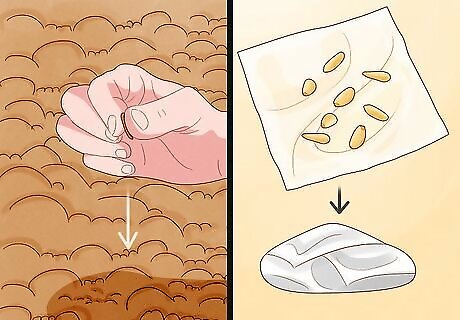
Decide whether to store the seeds before planting. Fresh pine seeds acquired in fall can usually be planted immediately. However, even fresh seeds may benefit from a special environment which increases the speed of germination (sprouting) and reduces the chance of your seeds staying dormant after planting. Storing seeds in this way to mimic ideal seasonal conditions is called stratification. Different species of pine tree do best in different conditions. Identify your species in a regional tree identification book or website if possible, and look up how long "stratification" takes. If you can't, the below methods should work as long as you check the seeds' progress regularly. In general, pines that grow in relatively warm climates further south (but not at high elevations) require little to no stratification before planting and can simply be stored dry at room temperature, while pines from damper, colder climates cannot grow without a cold, moist period.
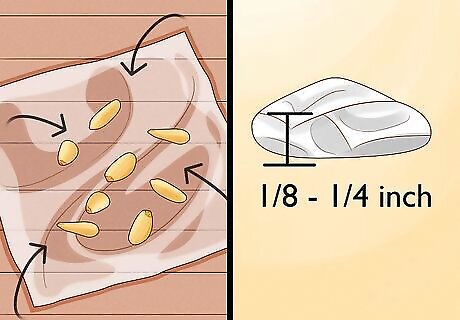
For a small quantity of seeds, store between moist paper towels. If you have a handful or two of seeds or fewer, this method may be easiest. Stack paper towels until the stack is 1/8 to 1/4 inch thick (3 to 6 mm). Add just enough water to moisten every part of the towels, then hold vertical by one corner until the excess water drains off. Place the seeds on one half of the paper towels in one layer, then fold the other half over the seeds. Seal in a ziploc or similar plastic bag and store in the refrigerator at about 41ºF (5ºC). You may wish to include a thick straw or other thin tube to allow a small amount of air exchange with the outside, to ensure the environment has sufficient oxygen. Note: certain species benefit from several weeks of storage in a warm, dark area before transfer to the refrigerator. The duration of this warm period varies widely by species, so search for specific information online if you can identify your seeds.
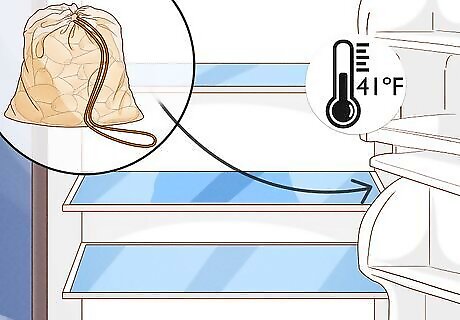
For a large quantity of seeds, store in a cheesecloth bag. Immediately after completing the soaking step, put half a pound (0.23 kg) of seeds or less onto a square of cheesecloth or other soft mesh material and tie it into a bag. Hang or hold up the bag and let the excess water drain for about a minute. Tie the neck of a larger, plastic bag to the neck of the cheesecloth so the water can continue to drain without soaking the seeds. Hang this in your refrigerator at about 41ºF (5ºC). Note: If you can identify your species, search for information on "stratification" for that species online. You may wish to store the bag in a warm location before transferring to the fridge.
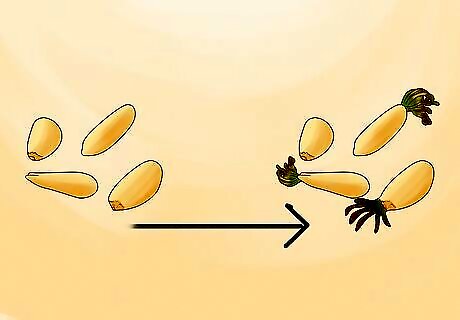
Check your seeds weekly for sprouting. A seed beginning to germinate will crack open and start to extend a growing root. Depending on the species and the individual seed, this could take anywhere from 3 weeks to multiple years, although you never need to store a seed for that long before planting. For seeds that refuse to sprout after several weeks, you can encourage them by letting them dry out, then repeating the treatment. If the growing season is over or you wish to save seeds for next year, dry the surface but leave them slightly damp, then store in the refrigerator. Keep checking regularly to be sure they don't sprout.
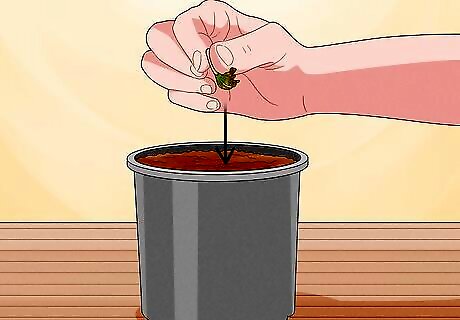
Plant the seeds in a tube or pot with a pine tree potting mix. Pine seeds are vulnerable to infection and rodents when planted in outdoor soil. Try to find plastic tubes intended for growing pine trees, as these are best for encouraging long root structures that will support the tree. Otherwise, an ordinary small plant pot will work. Instead of using soil, use a potting mix intended for pine trees, or create your own mix of 80% pine bark and 20% peat moss. Push the seeds just under the soil with the pointed root facing downward. If keeping the plants indoors, keep the pots on a raised table to make it more difficult for mice to reach them.
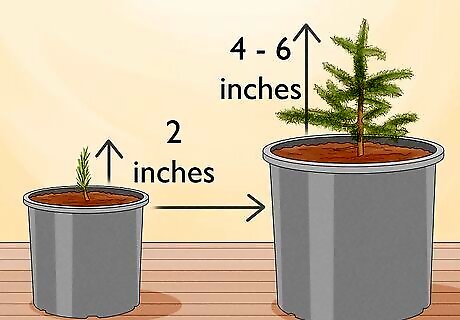
Care for your seedling. Follow the instructions for Caring for a Pine Tree Seedling to provide proper care. With the correct levels of sunlight and water, your tree should be ready to transplant into a taller tube or pot after one or two years, depending on the species. Pine trees grow best with plenty of sun, but young seedlings are susceptible to damage during the hottest part of the day. Place the seedling somewhere it will be shaded during the early afternoon, such as near an east-facing window. Keep the seedling moist but not soaked. Carefully transplant the seedling to a larger pot after it reaches 2 inches (5cm) in the smallest "multi pot" tubing, or once it reaches 4 to 6 inches (about 10 to 15 cm) in a medium sized tube or pot.















Comments
0 comment